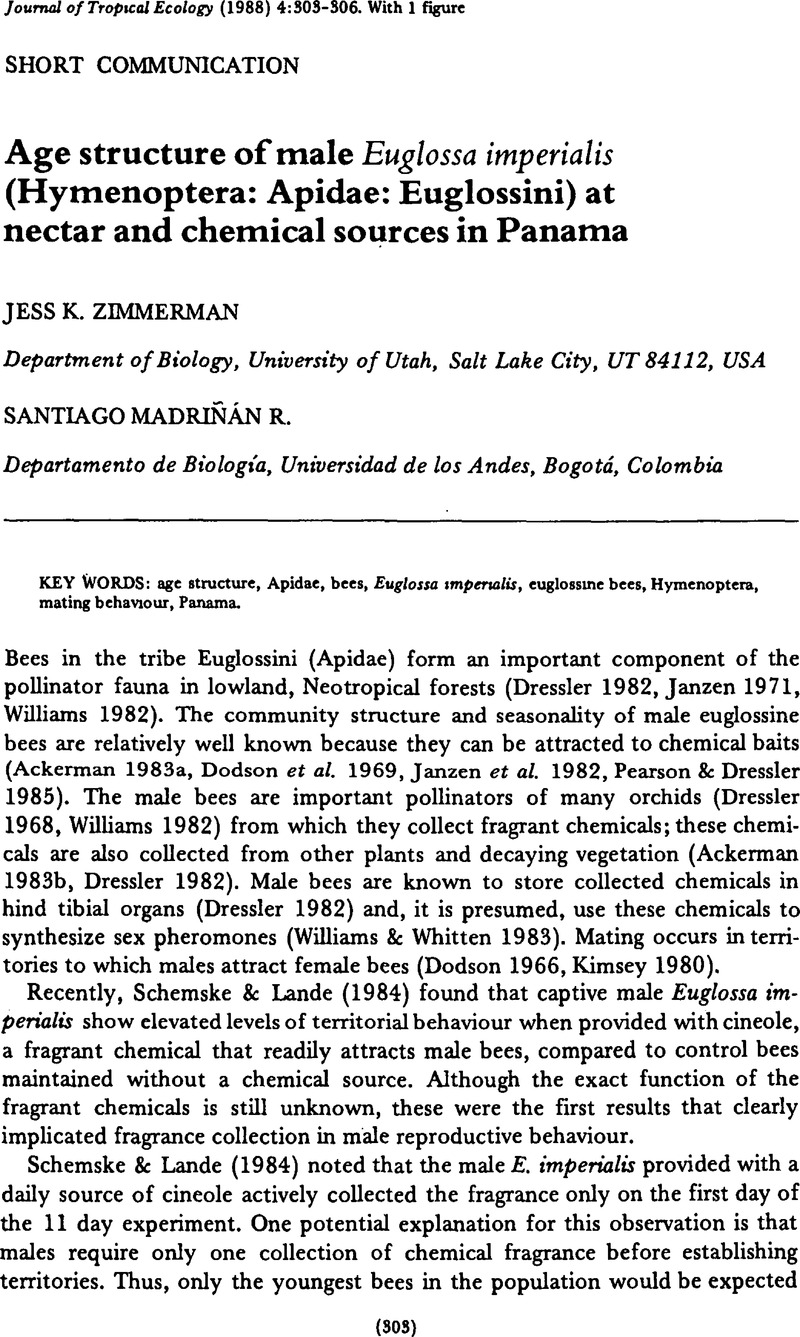Crossref Citations
This article has been cited by the following publications. This list is generated based on data provided by Crossref.
Oliveira, Mareio Luiz de
and
Campos, Lúcio Antônio de Oliveira
1996.
Preferência por estratos florestais e por substâncias odoríferas em abelhas Euglossinae (Hymenoptera, Apidae).
Revista Brasileira de Zoologia,
Vol. 13,
Issue. 4,
p.
1075.
Neves, Edinaldo L.
and
Viana, Blandina F.
1999.
Comunidade de machos de Euglossinae (Hymenoptera: Apidae) das matas ciliares da margem esquerda do médio Rio São Francisco, Bahia.
Anais da Sociedade Entomológica do Brasil,
Vol. 28,
Issue. 2,
p.
201.
Oliveira, Marcio Luiz de
1999.
Sazonalidade e horário de atividade de abelhas Euglossinae (Hymenoptera, Apidae), em florestas de terra firme na Amazônia Central.
Revista Brasileira de Zoologia,
Vol. 16,
Issue. 1,
p.
83.
BRITO, C. M. S. de
and
RÊGO, M. M. C.
2001.
Community of male Euglossini bees (Hymenoptera: Apidae) in a secondary forest, Alcântara, MA, Brazil.
Brazilian Journal of Biology,
Vol. 61,
Issue. 4,
p.
631.
López-Uribe, Margarita María
Oi, Cintia Akemi
and
Del Lama, Marco Antonio
2008.
Nectar-foraging behavior of Euglossine bees (Hymenoptera: Apidae) in urban areas.
Apidologie,
Vol. 39,
Issue. 4,
p.
410.
Storck-Tonon, Danielle
Morato, Elder Ferreira
and
Oliveira, Marcio Luiz
2009.
Fauna de euglossina (Hymenoptera: Apidae) da Amazônia sul-ocidental, Acre, Brasil.
Acta Amazonica,
Vol. 39,
Issue. 3,
p.
693.
Abrahamczyk, Stefan
Gottleuber, Peter
and
Kessler, Michael
2012.
Seasonal changes in odour preferences by male euglossine bees (Hymenoptera: Apidae) and their ecological implications.
Apidologie,
Vol. 43,
Issue. 2,
p.
212.
Rocha-Filho, L C
and
Garófalo, C A
2014.
Phenological Patterns and Preferences for Aromatic Compounds by Male Euglossine Bees (Hymenoptera, Apidae) in Two Coastal Ecosystems of the Brazilian Atlantic Forest.
Neotropical Entomology,
Vol. 43,
Issue. 1,
p.
9.
Padrón, Pablo S.
Roubik, David W.
and
Picón, Ruben P.
2018.
A Preliminary Checklist of the Orchid Bees (Hymenoptera: Apidae: Euglossini) of Ecuador.
Psyche: A Journal of Entomology,
Vol. 2018,
Issue. ,
p.
1.
Zajitschek, Felix
Zajitschek, Susanne
and
Bonduriansky, Russell
2020.
Senescence in wild insects: Key questions and challenges.
Functional Ecology,
Vol. 34,
Issue. 1,
p.
26.





